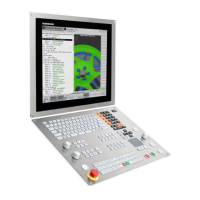Turning | Turning operations on milling machines (option 50)
16
674
HEIDENHAIN | TNC 640 | Conversational Programming User's Manual | 10/2017
16.1 Turning operations on milling machines
(option 50)
Introduction
Special types of milling machines allow performing both milling and
drilling operations. A workpiece can thus be machined completely
on one machine without rechucking, even if complex milling and
turning applications are required.
Turning is a machining operation during which the workpiece
rotates and thus performs the cutting movement. A fixed tool
carries out infeed and feed movements.
Turning applications, depending on machining direction and task,
are subdivided into various production processes, e.g.
Longitudinal turning
Face turning
Recess turning
Thread cutting
The control offers you several cycles for each of the
various production processes.
Further information: Cycle Programming User's
Manual
On the control you can simply switch between milling and turning
mode within the NC program. In turning mode, the rotary table
serves as lathe spindle, whereas the milling spindle with the tool is
fixed. This enables rotationally symmetric contours to be created.
The preset must be in the center of the lathe spindle for this.
When managing turning tools, different geometric descriptions
to those for milling or drilling tools are considered. To be able to
execute tool radius compensation, for example, you have to define
the tool radius. The control provides special tool management for
turning tools to support this definition process.
Further information: "Tool data", page 688
Different cycles are available for machining. These can also be used
with additional swivel axes.
Further information: "Inclined turning", page 704
Coordinate plane of turning operations
The assignment of the axes with turning is defined so that the
X coordinates describe the diameter of the workpiece and the Z
coordinates the longitudinal positions.
Programming is thus always done in the ZX coordinate plane. The
machine axes to be used for the required movements depend
on the respective machine kinematics and are determined by the
machine manufacturer. This makes NC programs with turning
functions largely exchangeable and independent of the machine
model.

